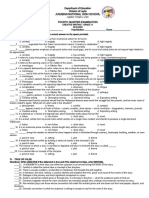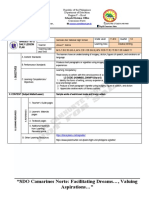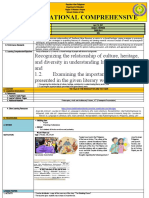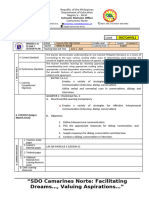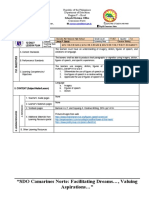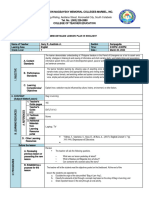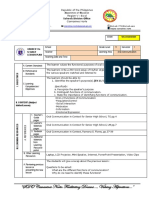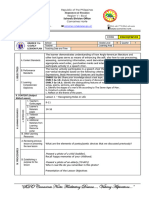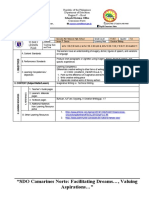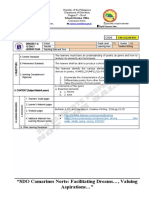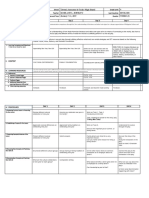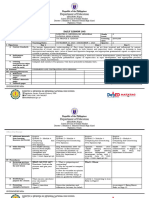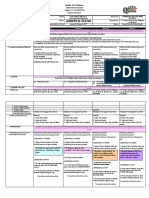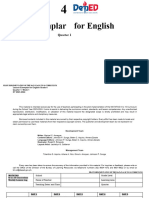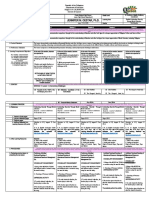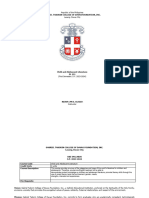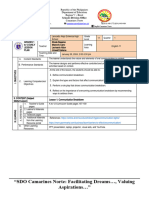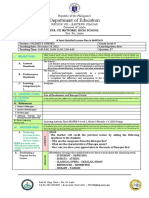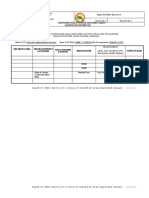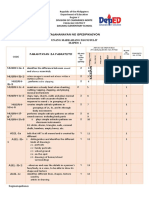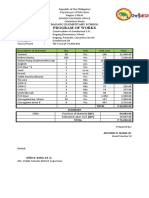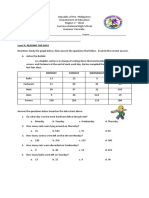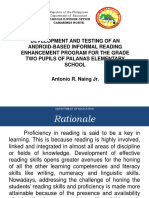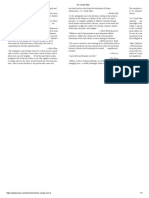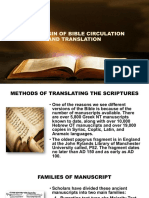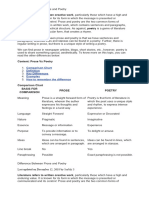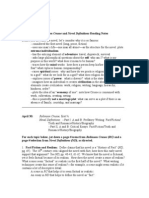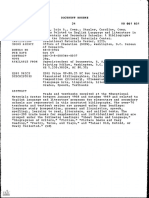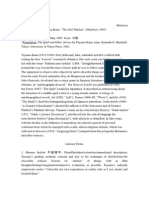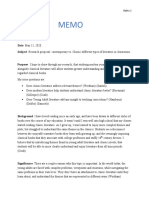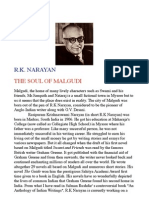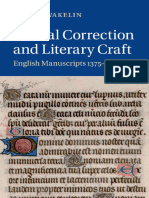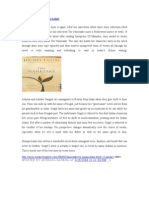ENG7Q1W1D1: Eco Athletic Field, F. Pimentel Ave.
ENG7Q1W1D1: Eco Athletic Field, F. Pimentel Ave.
Uploaded by
Joan Del Castillo NaingCopyright:
Available Formats
ENG7Q1W1D1: Eco Athletic Field, F. Pimentel Ave.
ENG7Q1W1D1: Eco Athletic Field, F. Pimentel Ave.
Uploaded by
Joan Del Castillo NaingOriginal Description:
Original Title
Copyright
Available Formats
Share this document
Did you find this document useful?
Is this content inappropriate?
Copyright:
Available Formats
ENG7Q1W1D1: Eco Athletic Field, F. Pimentel Ave.
ENG7Q1W1D1: Eco Athletic Field, F. Pimentel Ave.
Uploaded by
Joan Del Castillo NaingCopyright:
Available Formats
Republic of the Philippines
Department of Education
Region V – Bicol
Schools Division Office
Camarines Norte
Eco Athletic Field, F. Pimentel Ave., camarines.norte@deped.gov.ph (054) 440-1772/(054) 440-4464
Daet, Camarines Norte DepEd Camarines Norte
CODE ENG7Q1W1D1
GRADES 1 to School Grade Level 7 Quarter FIRST
12 DAILY Teacher Learning Area ENGLISH
LESSON PLAN Teaching Date and Time
The learner demonstrates understanding of: pre-colonial Philippine literature as a means of
A. Content Standards connecting to the past; various reading styles; ways of determining word meaning; the sounds
of English and the prosodic features of speech; and correct subject-verb agreement.
The learner transfers learning by: showing appreciation for the literature of the past;
comprehending texts using appropriate reading styles; participating in conversations using
I. OBJECTIVES
B. Performance Standards appropriate context-dependent expressions; producing English sounds correctly and using
the prosodic features of speech effectively in various situations; and observing correct
subject-verb agreement.
EN7LT-I-a-2: Describe the different literary genres during the pre-colonial period
EN7LT-I-a-2.1: Identify the distinguishing features of proverbs, myths, and legends
C. Learning Competencies/ • Identify the distinguishing features of proverbs, myths, and legends
Objectives • Differentiate proverbs, myths, and legends from one another
• Give the importance of proverbs, myths, and legends as different literary genres
during the pre-colonial period to show appreciation
II. CONTENT (Subject Matter/Lesson) Literary Genres during the Pre-Colonial Period: Proverbs, Myths, and Legends
pp. 14 - 18
1. Teacher’s Guide pages
A. REFERENCES
2. Learner’s Materials
pages pp. 12 – 17, 34 - 35
3. Textbook pages
4. Additional Materials from
CG: K to 12 English Curriculum Guide (May 2016) page 148
Learning Resource portal
III. LEARNING RESOURCES
Websites:
• http://www.differencebetween.net/language/words-language/difference-between-
legend-and-myth/
• https://www.slideshare.net/AttheaJaneLepiten/philippine-literature-and-texts-
precolonial-times-and-spanish-colonizations-77510710
• https://www.pitt.edu/~dash/creation-phil.html
B. Other Learning Resources • http://www.wowparadisephilippines.com/legend-mangoes.html
• https://www.tagaloglang.com/the-legend-of-mount-kanlaon/
Materials:
Pictures
Visual Aids
Activity Sheet/Worksheet/Task Sheet
Speaker
Laptop
“The Philippines during the Pro-Colonial Period”
PROCE
A. Reviewing previous lesson or Peer Activity
IV.
presenting the new lesson View each painting closely, with a partner, describe the kind of life the Filipinos had during
the Pre-Colonial Period:
ÂfWb VtÅtÜ|Çxá aÉÜàxM Ytv|Ä|àtà|Çz WÜxtÅá‹? itÄâ|Çz TáÑ|Ütà|ÉÇá‹Ê
Republic of the Philippines
Department of Education
Region V – Bicol
Schools Division Office
Camarines Norte
Eco Athletic Field, F. Pimentel Ave., camarines.norte@deped.gov.ph (054) 440-1772/(054) 440-4464
Daet, Camarines Norte DepEd Camarines Norte
Source: English 7 Learner’s Material pp. 12 - 15
Questions to be answered:
• What culture or tradition of Filipinos is depicted in each picture?
• What can you say about the life of Filipinos before based on the pictures shown
above?
• Is there any significant difference or similarity between the Filipinos before and at
present?
“Way of Life”
Peer Activity
Work with a partner and state your agreement or disagreement with the statements below:
Be ready to justify your stand.
1. The early Filipinos have high literacy rate.
2. They had no foreign relations.
3. They were not self-sufficient.
4. Several professions already existed.
5. They already had an advanced civilization.
6. Early Filipinos enjoyed a high standard of government.
B. Establishing a purpose for the 7. Our forefathers already possessed a working judicial and legislative system.
lesson Source: English 7 Learner’s Material p. 15
Questions to be answered:
• What do you feel upon knowing the stature of your ancestors during the period?
Why?
• Can you name some of the contributions of early Filipinos?
• Are their contributions still relevant to the present? Explain your answer.
• In what ways can we preserve these contributions?
Teacher’s inputs:
Every country has its own culture, beliefs, religion, and stories that are handed down
from one generation to another. These things affect how their people evolve and act the way
ÂfWb VtÅtÜ|Çxá aÉÜàxM Ytv|Ä|àtà|Çz WÜxtÅá‹? itÄâ|Çz TáÑ|Ütà|ÉÇá‹Ê
Republic of the Philippines
Department of Education
Region V – Bicol
Schools Division Office
Camarines Norte
Eco Athletic Field, F. Pimentel Ave., camarines.norte@deped.gov.ph (054) 440-1772/(054) 440-4464
Daet, Camarines Norte DepEd Camarines Norte
they do at present. They influence how they live their lives, especially the stories which are
either written or orally handed down. These stories tell of different things, people, places, and
events. While some tell stories about real people, some tell stories about fictional characters
that possess supernatural powers.
Source: http://www.differencebetween.net/language/words-language/difference-between-
legend-and-myth/
Owing to the works of our own archaeologists, ethnologists and anthropologists, we
are able to know more and better judge information about our pre-colonial times set against
a bulk of material about early Filipinos as recorded by Spanish, Chinese, Arabic and other
chroniclers of the past. Pre-colonial inhabitants of our islands showcase a rich past through
their folk speeches, folk songs, folk narratives and indigenous rituals and mimetic dances
that affirm our ties with our Southeast Asian neighbors.
Source: https://www.slideshare.net/AttheaJaneLepiten/philippine-literature-and-texts-
precolonial-times-and-spanish-colonizations-77510710
“Puzzle Me No More”
Individual Activity
Look at the boxes below. If you start at the top right hand square, then spiral clockwise
round the perimeter and finish at the central square, you spell out the word CLOCKWISE.
I S C
W E L
K C O
Now try the following items. Each word can start at any corner. Read for the clues. The
word to fill in the blank is the same word you spell out in the boxes.
1. Pre-colonial inhabitants of the Philippines have a rich oral __________ of literature.
T O I
R N T
A D I
2. One popular form of pre-colonial literature is the __________ basahanon in Bukidnon,
daraida and daragilon in Panay, salawikain in Luzon or sarsarita in Ilocos.
E R B ☺
V O R P
3. Filipino proverbs echo the ideals of the Philippines. Though they have been retold and
C. Presenting examples/instances
passed down from one generation to another, the __________ and lessons they impart to
of the new lesson
us still hold true to this day.
V A L
S E U
4. Dr. Damiana Eugenio, a renowned Filipina folklorist, says there is still no universally
accepted definition of the word __________ .
O L K L
R E F O
5. Any bit of knowledge handed down from generation to generation, which depicts the
beliefs and lifestyle of our ancestors of a chosen ethnic group is rendered __________ to
that group, and is respected as folklore.
Q U
I E
N U
Source: English 7 Learner’s Material pp. 16 - 17
Questions to be answered:
• What words did you form out of the puzzle?
• What do these words have in common?
Teacher’s inputs:
ÂfWb VtÅtÜ|Çxá aÉÜàxM Ytv|Ä|àtà|Çz WÜxtÅá‹? itÄâ|Çz TáÑ|Ütà|ÉÇá‹Ê
Republic of the Philippines
Department of Education
Region V – Bicol
Schools Division Office
Camarines Norte
Eco Athletic Field, F. Pimentel Ave., camarines.norte@deped.gov.ph (054) 440-1772/(054) 440-4464
Daet, Camarines Norte DepEd Camarines Norte
The variety and abundance of Philippine literature evolved even before the colonial
periods. Folk tales, epics, poems and marathon chants existed in most ethno linguistic groups
that were passed on from generation to generation through word of mouth. Tales associated
with the Spanish conquest also took part in the country’s rich cultural heritage.
Some of these pre-colonial literary pieces showcased in traditional narratives,
speeches and songs are tigmo in Cebuano, bugtong in Tagalog, patototdon in Bicol and
paktakon in Ilongo. Philippine epics and folk tales are varied and filled with magical
characters. They are either narratives of mostly mythical objects, persons or certain places,
or epics telling supernatural events and bravery of heroes, customs and ideologies of a
community.
Source: https://www.slideshare.net/AttheaJaneLepiten/philippine-literature-and-texts-
precolonial-times-and-spanish-colonizations-77510710
“Under the Lens”
Reading Activity
Read the following texts. Be ready to answer the questions that follow:
TEXT A:
“How the Moon and the Stars Came to Be”
Bukidnon (Mindanao)
One day in the times when the sky was close to the ground a spinster went out to
pound rice. Before she began her work, she took off the beads from around her neck and
the comb from her hair, and hung them on the sky, which at that time looked like coral
rock.
Then she began working, and each time that she raised her pestle into the air it
struck the sky. For some time she pounded the rice, and then she raised the pestle so
high that it struck the sky very hard.
Immediately the sky began to rise, and it went up so far that she lost her
ornaments. Never did they come down, for the comb became the moon and the beads
are the stars that are scattered about.
Source: https://www.pitt.edu/~dash/creation-phil.html
TEXT B:
D. Discussing new concepts and “The Legend of Mount Kanlaon”
practicing new skills #1 There once lived on the island of Negros a princess named Anina who lived a very
sheltered life.
One day, Anina overheard her father talking to the kingdom’s chief priestess. The
priestess was frantic about a report that they could not find a single maiden who was
unblemished.
Later, Anina asked her father what it was all about, and the king finally broke down.
There had long been a seven-headed dragon threatening the kingdom, and the monster
could only be appeased if an unblemished maiden was sacrificed to it.
In fear, all the women in the kingdom had cut themselves to disqualify themselves
from the sacrifice. Parents cut their own baby girls so as to spare the infants from the
sacrifice. But the king and the queen couldn’t bring themselves to mar their daughter’s
beauty, and so Anina was the only remaining unscarred female in the kingdom.
Anina did not weep. Instead, she willingly offered herself for the sacrifice.
Fortuitously, on the day she was to be brought to the mountain where the dragon lived, a
man calling himself Khan Laon appeared. (Khan in his language meant a noble lord.) He
said he came from a kingdom far away in order to slay the dragon and spare Anina’s life.
No one believed the dragon could be killed, but Khan Laon insisted that his ability
to talk to animals would help him. He asked the help of the ants, the bees and the eagles.
The ants swarmed over the dragon’s body and crept under its scales to bite its soft,
unprotected flesh, while the bees stung the fourteen eyes of the dragon till it was blind.
ÂfWb VtÅtÜ|Çxá aÉÜàxM Ytv|Ä|àtà|Çz WÜxtÅá‹? itÄâ|Çz TáÑ|Ütà|ÉÇá‹Ê
Republic of the Philippines
Department of Education
Region V – Bicol
Schools Division Office
Camarines Norte
Eco Athletic Field, F. Pimentel Ave., camarines.norte@deped.gov.ph (054) 440-1772/(054) 440-4464
Daet, Camarines Norte DepEd Camarines Norte
The largest eagle carried Khan Laon to the mountain where he was able to easily chop
off the seven heads of the writhing beast.
In gratitude, the king gave Khan Laon his daughter Anina to be his bride, and the
people named the mountain after the noble lord.
And that is how, according to the story, Mount Kanlaon got its name. That it is a
volcano is because of the spirt of the dead dragon.
Source: https://www.tagaloglang.com/the-legend-of-mount-kanlaon/
TEXT C:
Source: English 7 Learner’s Material p. 35
Questions to be answered:
• What are the characteristics specific to each text?
• How are the texts similar to each other?
• How are the texts different from one another?
Teacher’s inputs:
In general, myth is a narrative that describes and portrays in symbolic language the
origin of the basic elements and assumptions of a culture. Mythic narrative relates, for
example, how the world began, how humans and animals were created, and how certain
customs, gestures, or forms of human activities originated. Almost all cultures possess or at
one time possessed and lived in terms of myths.
Myths are traditional stories occurring in a timeless past. They involve supernatural
elements and are beyond the frontiers of logic. Although myths are not based on objective
truth, they reflect both universal worries and the worries of specific cultures.
A legend is set in a specific place at a specific time; the subject is often a heroic
historical personage. A legend differs from a myth by portraying a human hero rather than
one who is a god. Legends, originally oral, have been developed into literary masterpieces.
A proverb is a simple and concrete saying, popularly known and repeated, that
expresses a truth based on common sense or experience. They are often metaphorical. A
proverb that describes a basic rule of conduct may also be known as a maxim. These have
been customarily used and served as laws or rules on good behavior by our ancestors. To
others, these are like allegories or parables that impart lessons for the young. The proverbs
or aphorisms express norms or codes of behavior, community beliefs or they instill values by
offering nuggets of wisdom in short, rhyming verse.
Source: https://www.slideshare.net/AttheaJaneLepiten/philippine-literature-and-texts-
precolonial-times-and-spanish-colonizations-77510710
E. Discussing new concepts and
practicing skills #2
F. Developing mastery Oral Presentation
ÂfWb VtÅtÜ|Çxá aÉÜàxM Ytv|Ä|àtà|Çz WÜxtÅá‹? itÄâ|Çz TáÑ|Ütà|ÉÇá‹Ê
Republic of the Philippines
Department of Education
Region V – Bicol
Schools Division Office
Camarines Norte
Eco Athletic Field, F. Pimentel Ave., camarines.norte@deped.gov.ph (054) 440-1772/(054) 440-4464
Daet, Camarines Norte DepEd Camarines Norte
Form three groups. Each groups will be tasked to do the following:
Group I: Read and analyze the myth that follows:
In the Beginning
Bilaan (Mindanao)
In the beginning there were four beings (Melu, Fiuweigh, Diwata, and Saweigh), and
they lived on an island no larger than a hat. On this island there were no trees or grass or
any other living thing besides these four people and one bird (Buswit). One day they sent this
bird out across the waters to see what he could find, and when he returned he brought some
earth, a piece of rattan, and some fruit.
Melu, the greatest of the four, took the soil and shaped it and beat it with a paddle in
the same manner in which a woman shapes pots of clay, and when he finished he had made
the earth. Then he planted the seeds from the fruit, and they grew until there was much rattan
and many trees bearing fruit.
The four beings watched the growth for a long time and were well pleased with the
work, but finally Melu said, "Of what use is this earth and all the rattan and fruit if there are
no people?"
And the others replied, "Let us make some people out of wax."
So they took some wax and worked long, fashioning it into forms, but when they brought
them to the fire the wax melted, and they saw that men could not be made in that way.
Next they decided to try to use dirt in making people, and Melu and one of his
companions began working on that. All went well till they were ready to make the noses. The
companion, who was working on that part, put them on upside down. Melu told him that the
people would drown if he left them that way, but he refused to change them.
When his back was turned, however, Melu seized the noses, one by one, and turned
them as they now are. But he was in such a hurry that he pressed his finger at the root, and
it left a mark in the soft clay which you can still see on the faces of people.
Source: https://www.pitt.edu/~dash/creation-phil.html
Answer the following questions:
• What is the myth all about?
• What lesson does the myth teach its readers?
Group II: Read and analyze the legend that follows:
“The Legend of Mangoes”
Once upon a time, there was a little boy named Ben who had a wonderful heart. He is
the son of Maria and Juan. Ben’s a kind and helpful young lad who was nurtured well by his
parents who have good hearts as well.
One day, Ben saw a very old beggar and he took pity on him. So, Ben decided to invite
the old beggar into their humble home and he cooked food and fed the old beggar until he
could not eat anymore. Ben was not a rich boy but that did not stop him from helping this old
beggar by serving him with the type of food that Ben’s family could only afford. After a
sumptuous meal, the beggar thanked the young lad and bade him farewell.
On another day, while Ben was looking for fire woods, he passed by an old man who
was also very hungry. Ben took pity on him once more and without a doubt in his mind, he
invited the old man back to their home and gave him food and some clothes that his father
does not use anymore. Ben’s parents were happy that they have a son who has a heart of
gold like Ben.
Unfortunately, the time came that Ben suddenly got very ill. His parents were troubled
and didn’t know what to do. But despite that, they persisted to have their son treated but to
no avail, Ben died. His parents mourned over the loss of their only son. The next day, after
Ben’s death, a beautiful fairy came to Ben’s wake and talked to his parents. She asked them
to give her Ben’s heart. They agreed and gave it to her. The fairy then flew away and in a
mountain, she dug and buried Ben’s dead heart. It then turned into a fruit-bearing tree whose
fruits were in the shape of a heart and whose taste was so sweet. People were amazed upon
ÂfWb VtÅtÜ|Çxá aÉÜàxM Ytv|Ä|àtà|Çz WÜxtÅá‹? itÄâ|Çz TáÑ|Ütà|ÉÇá‹Ê
Republic of the Philippines
Department of Education
Region V – Bicol
Schools Division Office
Camarines Norte
Eco Athletic Field, F. Pimentel Ave., camarines.norte@deped.gov.ph (054) 440-1772/(054) 440-4464
Daet, Camarines Norte DepEd Camarines Norte
discovering this new type of fruit and when they tasted it they were happy as it’s the sweetest
fruit they have ever tasted.
From then till now, people enjoy the benefits of this wonderful fruit.
Source: http://www.wowparadisephilippines.com/legend-mangoes.html
Answer the following questions:
• What is the legend all about?
• What lesson does the legend teach its readers?
Group III: Advice from the Ancient (English 7 Learner’s Material pp. 12 - 15)
Read and analyze the proverb that follows:
“Dai mo pagpaagahan an magigibomo ngonyan.” (Bikol)
Do not put off for tomorrow what you can do for today.
Answer the following questions:
• What is the message of the proverb?
• What lesson does the proverb teach its readers?
• What kind of people do you think created this proverb? Why?
Differentiate Proverbs, Myths, and Legends from one another using the Venn Diagram
below:
Proverb
Myth Legend
G. Making generalizations and
abstractions about the lesson
Teacher’s inputs:
1. Proverbs are brief instructive expression that suggest a specific action, behavior or
judgement.
2. A legend is a traditional or historical story about people, places, and events of ancient
times while a myth is also a traditional story of how certain customs came into being.
3. A legend is a story of real people with super powers while a myth is a story of gods and
divine beings.
4. Proverbs, Myths, and Legends intend to teach a lesson with people.
Source: http://www.differencebetween.net/language/words-language/difference-between-
legend-and-myth/
H. Finding practical applications of
Question to be asked:
concepts and skills in daily
• How relevant are proverbs in Philippine literature?
living
ÂfWb VtÅtÜ|Çxá aÉÜàxM Ytv|Ä|àtà|Çz WÜxtÅá‹? itÄâ|Çz TáÑ|Ütà|ÉÇá‹Ê
Republic of the Philippines
Department of Education
Region V – Bicol
Schools Division Office
Camarines Norte
Eco Athletic Field, F. Pimentel Ave., camarines.norte@deped.gov.ph (054) 440-1772/(054) 440-4464
Daet, Camarines Norte DepEd Camarines Norte
• How relevant are myths in Philippine literature?
• How relevant are legends in Philippine literature?
Identify whether the following statements refer to Myth/s, Legend/s or Proverb/s. Write your
answer on the space provided.
___________ 1. Traditional and/or religious stories that take place in a timeless past that
incorporate invented characters—usually supernatural entities, such as deities and demigods
and fantastical story elements (e.g., a flying, magic carpet).
___________ 2. Stories about real people who are famous for doing something brave or
I. Evaluating learning extraordinary.
___________ 3. These have been customarily used and served as laws or rules on good
behavior by our ancestors.
___________ 4. Used to explain seemingly unexplainable phenomena regarding how and
why the world works the way it does or why people behave the way they do.
___________ 5. Express norms or codes of behavior, community beliefs or they instill values
by offering nuggets of wisdom in short, rhyming verse.
J. Additional activities for Print and/or cut out an example of proverb, myth and legend popular in your community.
application or remediation Paste them in your notebook. Be ready to share your output with the rest of the class.
V. REMARKS
A. No. of learners who earned 80%
in the evaluation
B. No. of learners who require
additional activities for
remediation
C. Did the lesson work? No. of
learners who have caught up w/
VI. REFLECTION
the lesson
D. No. of learners who continue to
require remediation
E. Which of my teaching strategies
worked well? Why did these
work?
F. What difficulties did I encounter
which my principal or supervisor
can help me solve?
G. What innovation or localized
materials did I use/discover
which I wish to share with other
teachers?
ÂfWb VtÅtÜ|Çxá aÉÜàxM Ytv|Ä|àtà|Çz WÜxtÅá‹? itÄâ|Çz TáÑ|Ütà|ÉÇá‹Ê
Republic of the Philippines
Department of Education
Region V – Bicol
Schools Division Office
Camarines Norte
Eco Athletic Field, F. Pimentel Ave., camarines.norte@deped.gov.ph (054) 440-1772/(054) 440-4464
Daet, Camarines Norte DepEd Camarines Norte
PROCEDURES NOTES / SUGGESTIONS / RECOMMENDATIONS
A. Reviewing previous lesson
or presenting the new
lesson
B. Establishing a purpose for
the lesson
C. Presenting
examples/instances of the
new lesson
D. Discussing new concepts
and practicing new skills #1
E. Discussing new concepts
and practicing skills #2
F. Developing mastery
G. Making generalizations and
abstractions about the
lesson
H. Finding practical
applications of concepts
and skills in daily living
I. Evaluating learning
J. Additional activities for
application or remediation
ÂfWb VtÅtÜ|Çxá aÉÜàxM Ytv|Ä|àtà|Çz WÜxtÅá‹? itÄâ|Çz TáÑ|Ütà|ÉÇá‹Ê
You might also like
- Mass Civilization and Minority Culture by F. R. Leavis - 1930Document4 pagesMass Civilization and Minority Culture by F. R. Leavis - 1930Emanuelle SantosNo ratings yet
- Gaye Williams Ortiz, Clara A.B. Joseph - Theology and Literature - Rethinking Reader Responsibility (2006) PDFDocument253 pagesGaye Williams Ortiz, Clara A.B. Joseph - Theology and Literature - Rethinking Reader Responsibility (2006) PDFAnonymous Ipt7DRCRDNo ratings yet
- Eccd ComputationDocument13 pagesEccd ComputationJoan Del Castillo Naing100% (1)
- 4th Quarter Exam Creative WritingDocument5 pages4th Quarter Exam Creative WritingMARIAN TIMTIMAN100% (1)
- IB English LangLit Written Task Great GatsbyDocument3 pagesIB English LangLit Written Task Great GatsbyDmitry KarabutovNo ratings yet
- CW11Q1W2D2Document6 pagesCW11Q1W2D2Josua GarciaNo ratings yet
- CW11Q1W2D4Document6 pagesCW11Q1W2D4Josua GarciaNo ratings yet
- CW11Q1W2D3Document6 pagesCW11Q1W2D3Josua GarciaNo ratings yet
- LP ENGLISH8 COT 3rdQDocument10 pagesLP ENGLISH8 COT 3rdQRHODA MAE FORMONNo ratings yet
- Bernal DLP Q4W2 Final For Print SY 2022Document13 pagesBernal DLP Q4W2 Final For Print SY 2022Jeanisil CerenoNo ratings yet
- CW11Q1W2D1Document6 pagesCW11Q1W2D1Josua GarciaNo ratings yet
- Biag Ni Lam Ang SampaguitaDocument6 pagesBiag Ni Lam Ang SampaguitaSandra Mae Endencio EllamaNo ratings yet
- OC11Q1W3D1 Draft 1 TrueDocument6 pagesOC11Q1W3D1 Draft 1 TrueChristine ApinNo ratings yet
- Creative Writing - Week 3Document6 pagesCreative Writing - Week 3Rio OrpianoNo ratings yet
- Department of Education: Republic of The PhilippinesDocument5 pagesDepartment of Education: Republic of The Philippinesviafrance.adoconNo ratings yet
- Grade Level 7 TeacherDocument6 pagesGrade Level 7 TeacherMaria Fatima MagsinoNo ratings yet
- English 7 q1 Curriculum MapDocument36 pagesEnglish 7 q1 Curriculum MapAngelica JessaNo ratings yet
- Eng9 Q1W1D3Document6 pagesEng9 Q1W1D3Kuting MVNo ratings yet
- Grade 8 - Factual Text, Personal Recount and Persuasive TextDocument7 pagesGrade 8 - Factual Text, Personal Recount and Persuasive TextLeah MatiasNo ratings yet
- Week 1-Day 1Document4 pagesWeek 1-Day 1AmorNo ratings yet
- Department of Education: Republic of The PhilippinesDocument4 pagesDepartment of Education: Republic of The Philippinesviafrance.adoconNo ratings yet
- CPG English Grade 7 (1st-2nd Quarter)Document34 pagesCPG English Grade 7 (1st-2nd Quarter)Era ParkNo ratings yet
- DLL English 10 Q1 - Module 1 - Lesson 5 - Formal and Informal Definition of Words, How Odin Lost His EyeDocument10 pagesDLL English 10 Q1 - Module 1 - Lesson 5 - Formal and Informal Definition of Words, How Odin Lost His EyeJennifer OestarNo ratings yet
- DLL ENG8 1stQ 1st Week CheckedDocument9 pagesDLL ENG8 1stQ 1st Week CheckedREGINE MAY CARIÑO BRAGADONo ratings yet
- EAPP11S1Q1W7D2Document9 pagesEAPP11S1Q1W7D2melany r. malvarosaNo ratings yet
- CW11Q1W3D3Document7 pagesCW11Q1W3D3Josua GarciaNo ratings yet
- Daily Lesson Log in English 8: Republic of The Philippines Region Iii Schools Division of Cabanatuan CityDocument4 pagesDaily Lesson Log in English 8: Republic of The Philippines Region Iii Schools Division of Cabanatuan CityRegine Grace OligarioNo ratings yet
- CW11Q1W1D1Document6 pagesCW11Q1W1D1Josua GarciaNo ratings yet
- Department of Education: Republic of The PhilippinesDocument5 pagesDepartment of Education: Republic of The Philippinesviafrance.adoconNo ratings yet
- Features of Legends, Proverbs, and MythsDocument16 pagesFeatures of Legends, Proverbs, and MythsJustine MingoNo ratings yet
- COT G10 Mar 21Document7 pagesCOT G10 Mar 21Cristina LolosNo ratings yet
- Department of Education: Republic of The PhilippinesDocument4 pagesDepartment of Education: Republic of The Philippinesviafrance.adoconNo ratings yet
- LE G4 English Q1 Wk1Document19 pagesLE G4 English Q1 Wk1JOHN RUBIE INSIGNENo ratings yet
- CW11Q1W3D1Document6 pagesCW11Q1W3D1Josua GarciaNo ratings yet
- Department of Education: Daily Lesson LogDocument4 pagesDepartment of Education: Daily Lesson LogKimberley Sicat BautistaNo ratings yet
- DLL SampleDocument10 pagesDLL SampleClaudia BomedianoNo ratings yet
- CPDD 06 Rev 01 AffidavitOfUndertakingDocument3 pagesCPDD 06 Rev 01 AffidavitOfUndertakingMay-Ann S. CahiligNo ratings yet
- DLL ENG8 1stQ MGCMDocument34 pagesDLL ENG8 1stQ MGCMMaryGrace Cruz-MatienzoNo ratings yet
- LESSON PLAN USING OTHER APPROACHES ENGLISH-3-merlyDocument12 pagesLESSON PLAN USING OTHER APPROACHES ENGLISH-3-merlyMerly abetsuelaNo ratings yet
- Department of Education: Republic of The PhilippinesDocument5 pagesDepartment of Education: Republic of The Philippinesviafrance.adoconNo ratings yet
- DLL Week28 Jan7-11Document3 pagesDLL Week28 Jan7-11Julia GaborNo ratings yet
- Department of Education: Republic of The PhilippinesDocument5 pagesDepartment of Education: Republic of The Philippinesviafrance.adoconNo ratings yet
- English 7 W5 Q1Document10 pagesEnglish 7 W5 Q1Jonesse Dean Dela CruzNo ratings yet
- Annual Didactic Program 8°Document13 pagesAnnual Didactic Program 8°femirandaz1975No ratings yet
- Jane-Larra - Lesson Plan KodocxDocument3 pagesJane-Larra - Lesson Plan KodocxJustine MingoNo ratings yet
- DLL 21st Century Li Wk12Document8 pagesDLL 21st Century Li Wk12Jennifer L. Magboo-OestarNo ratings yet
- DLL English 10 - Module 1 - Lesson 4 - Motivational VideoDocument7 pagesDLL English 10 - Module 1 - Lesson 4 - Motivational VideoJennifer OestarNo ratings yet
- LE English4 Week1 v.2 FINALDocument20 pagesLE English4 Week1 v.2 FINALNerissa MendezNo ratings yet
- COT G10 Mar 16Document8 pagesCOT G10 Mar 16Cristina LolosNo ratings yet
- English 7 DLLDocument50 pagesEnglish 7 DLLrobinaNo ratings yet
- DLL English 10 Q1 - Module 1 - Lesson 2 - Reflection, The Gorgon's HeadDocument9 pagesDLL English 10 Q1 - Module 1 - Lesson 2 - Reflection, The Gorgon's HeadJennifer OestarNo ratings yet
- DLL 1 QiDocument8 pagesDLL 1 QiDaisy Jade DatoNo ratings yet
- CPAR 10 01 q2Document3 pagesCPAR 10 01 q2krieztjanblancaverNo ratings yet
- DLL 3rd WeekDocument5 pagesDLL 3rd WeekJERALLI ROSE VALENCIA-HERNANDEZNo ratings yet
- El 111Document9 pagesEl 111Reina Lyn Elegio, LPTNo ratings yet
- Detailed Lesson Plan - DepedDocument10 pagesDetailed Lesson Plan - Depedleonardoalbor05No ratings yet
- CW11Q1W4D2Document7 pagesCW11Q1W4D2Josua GarciaNo ratings yet
- Eng7Q1W4D2: Âfwb Vtåtü - Çxá Aéüàxm Ytv - Ä - Àtà - ÇZ Wüxtåá ? Itäâ - ÇZ Táñ - Ütà - Éçá ÊDocument6 pagesEng7Q1W4D2: Âfwb Vtåtü - Çxá Aéüàxm Ytv - Ä - Àtà - ÇZ Wüxtåá ? Itäâ - ÇZ Táñ - Ütà - Éçá ÊJENNYLOU PAGAONo ratings yet
- Division of Batangas Bayanan National High School: Believe Nurture Hope ServeDocument2 pagesDivision of Batangas Bayanan National High School: Believe Nurture Hope ServeAnnie AriagaNo ratings yet
- 11.14.music 9 Quarter 2Document3 pages11.14.music 9 Quarter 2Mildred PermejoNo ratings yet
- Week 1Document6 pagesWeek 1God's PrincessNo ratings yet
- This Study Resource Was: Bugtong-At-Sagot-Tagalog-Riddles-Answers - HTMLDocument4 pagesThis Study Resource Was: Bugtong-At-Sagot-Tagalog-Riddles-Answers - HTMLJheris MartinNo ratings yet
- LANGUAGEDocument3 pagesLANGUAGEJane BallicudNo ratings yet
- Teacher Guide for A Girl Called Echo: Learning About the History and Culture of the Métis Nation in Grades 6–8From EverandTeacher Guide for A Girl Called Echo: Learning About the History and Culture of the Métis Nation in Grades 6–8No ratings yet
- Table 1-F: Status of Identified Unaccomplished Outputs (Ppas) For The QuarterDocument2 pagesTable 1-F: Status of Identified Unaccomplished Outputs (Ppas) For The QuarterJoan Del Castillo NaingNo ratings yet
- Action-Plan AndayDocument4 pagesAction-Plan AndayJoan Del Castillo NaingNo ratings yet
- Schools Division Office Camarines Norte Dagang Elementary School Paracale District Project ProposalDocument2 pagesSchools Division Office Camarines Norte Dagang Elementary School Paracale District Project ProposalJoan Del Castillo Naing100% (1)
- Summary of Physical and Financial Accomplishment: Schools Division OfficeDocument2 pagesSummary of Physical and Financial Accomplishment: Schools Division OfficeJoan Del Castillo Naing100% (5)
- Ok Sa Deped TemplateDocument7 pagesOk Sa Deped TemplateJoan Del Castillo NaingNo ratings yet
- 1st Quarter Division Monitoring, Evaluation and Adjustment (DMEA)Document5 pages1st Quarter Division Monitoring, Evaluation and Adjustment (DMEA)Joan Del Castillo NaingNo ratings yet
- Department of Education: Republic of The PhilippinesDocument1 pageDepartment of Education: Republic of The PhilippinesJoan Del Castillo NaingNo ratings yet
- Accom July3Document13 pagesAccom July3Joan Del Castillo NaingNo ratings yet
- Tos-Test Mapeh 1Document6 pagesTos-Test Mapeh 1Joan Del Castillo NaingNo ratings yet
- Disbursement Voucher: Juan Dela CruzDocument9 pagesDisbursement Voucher: Juan Dela CruzJoan Del Castillo NaingNo ratings yet
- Department of Education: Republic of The PhilippinesDocument1 pageDepartment of Education: Republic of The PhilippinesJoan Del Castillo NaingNo ratings yet
- Abc Plus Participants: Noel - Ibis001@deped - Gov.phDocument1 pageAbc Plus Participants: Noel - Ibis001@deped - Gov.phJoan Del Castillo NaingNo ratings yet
- Pretest Graph ResearchDocument11 pagesPretest Graph ResearchJoan Del Castillo NaingNo ratings yet
- Pretest Graph ResearchDocument11 pagesPretest Graph ResearchJoan Del Castillo NaingNo ratings yet
- Program of Works: Dagang Elementary SchoolDocument2 pagesProgram of Works: Dagang Elementary SchoolJoan Del Castillo Naing100% (1)
- Schools Division Office Camarines Norte Dagang Elementary School Paracale District Project ProposalDocument5 pagesSchools Division Office Camarines Norte Dagang Elementary School Paracale District Project ProposalJoan Del Castillo Naing100% (1)
- PDS AttachmentDocument1 pagePDS AttachmentJoan Del Castillo NaingNo ratings yet
- DLL - Mapeh 4 - Q1 - W3Document5 pagesDLL - Mapeh 4 - Q1 - W3Joan Del Castillo NaingNo ratings yet
- Post Test' Graph ResearchDocument11 pagesPost Test' Graph ResearchJoan Del Castillo NaingNo ratings yet
- Palmero Eldie A. Internet ResearchDocument3 pagesPalmero Eldie A. Internet ResearchJoan Del Castillo NaingNo ratings yet
- OralP Resentation AntonDocument13 pagesOralP Resentation AntonJoan Del Castillo NaingNo ratings yet
- Work and Financial Plan School-Based Feeding Program (SBFP)Document9 pagesWork and Financial Plan School-Based Feeding Program (SBFP)Joan Del Castillo Naing50% (2)
- All Types of Learners of The SchoolDocument6 pagesAll Types of Learners of The SchoolJoan Del Castillo NaingNo ratings yet
- William Opcrf 2016-2017Document10 pagesWilliam Opcrf 2016-2017Joan Del Castillo NaingNo ratings yet
- Ice-Candy-Man Ebook by Bapsi Sidhwa - 9789351181194 - Rakuten KoboDocument1 pageIce-Candy-Man Ebook by Bapsi Sidhwa - 9789351181194 - Rakuten KoboFarman Khan LashariNo ratings yet
- Ghl. Special Revelation - History of Bible TranslationDocument44 pagesGhl. Special Revelation - History of Bible TranslationNezer VergaraNo ratings yet
- Mahabharat Reflection in ManagementDocument3 pagesMahabharat Reflection in ManagementLokanath ChoudhuryNo ratings yet
- Difference Between Prose and PoetryDocument7 pagesDifference Between Prose and PoetryRichelle Cayubit Dela Peña-LosdoNo ratings yet
- English 606-Robinson Crusoe NotesDocument3 pagesEnglish 606-Robinson Crusoe NotesDaniel ValdezNo ratings yet
- THE ROAD NOT TAKEN Robert FrostDocument4 pagesTHE ROAD NOT TAKEN Robert FrostFrostNo ratings yet
- F. Sionil José PresentationDocument12 pagesF. Sionil José PresentationMnM Vlog OfficialNo ratings yet
- Poem of ReturnDocument13 pagesPoem of Return5n0wm4n504No ratings yet
- Ed 039236Document29 pagesEd 039236Sabri SabelNo ratings yet
- Study Guide: Tayama Katai "The Girl Watcher" (Shōjobyō, 1907)Document3 pagesStudy Guide: Tayama Katai "The Girl Watcher" (Shōjobyō, 1907)BeholdmyswarthyfaceNo ratings yet
- Research ProposalDocument6 pagesResearch Proposalapi-517882844No ratings yet
- Anne Frank Character Sketch Class 10Document2 pagesAnne Frank Character Sketch Class 10Pallavi PaldheNo ratings yet
- Insights Into Challenges: Assignment 1: Case StudyDocument6 pagesInsights Into Challenges: Assignment 1: Case Studyapi-525572712No ratings yet
- History of Information ScienceDocument51 pagesHistory of Information ScienceJeremyCahillNo ratings yet
- Popular Literature PPT 1Document32 pagesPopular Literature PPT 1Nicole R. Ilagan100% (2)
- Summative 1 LiteratureDocument3 pagesSummative 1 LiteratureMichelle SarmientoNo ratings yet
- Substitution As A Device of Grammatical CohesionDocument10 pagesSubstitution As A Device of Grammatical CohesionLacey CondeNo ratings yet
- R K Narayan Biography NoteDocument2 pagesR K Narayan Biography NoteDeva Sravan Kumar Sarma100% (6)
- Makalah Kelompok 3, Alone Poem by Edgar Allan PoeDocument8 pagesMakalah Kelompok 3, Alone Poem by Edgar Allan Poemeldianto manugalaNo ratings yet
- The Middle AgesDocument3 pagesThe Middle AgesKata TóthNo ratings yet
- Seto Et Al 2012 Urban Land Teleconnections and SustainabilityDocument10 pagesSeto Et Al 2012 Urban Land Teleconnections and SustainabilityIndraNo ratings yet
- Definition of LyricDocument8 pagesDefinition of LyricNikhil IyerNo ratings yet
- Harrington Umn 0130E 13369Document256 pagesHarrington Umn 0130E 13369Mary Joy RellomaNo ratings yet
- D. Wakelin. (2014) - Scribal Correction and Literary Craft. English Manuscripts 1375-1510. Cambridge - Cambridge University Press.Document369 pagesD. Wakelin. (2014) - Scribal Correction and Literary Craft. English Manuscripts 1375-1510. Cambridge - Cambridge University Press.Carolina Mircin100% (2)
- The Flint Heart Teachers' GuideDocument4 pagesThe Flint Heart Teachers' GuideCandlewick PressNo ratings yet
- Jhumpa LahiriDocument5 pagesJhumpa Lahiridhana sekar100% (2)



